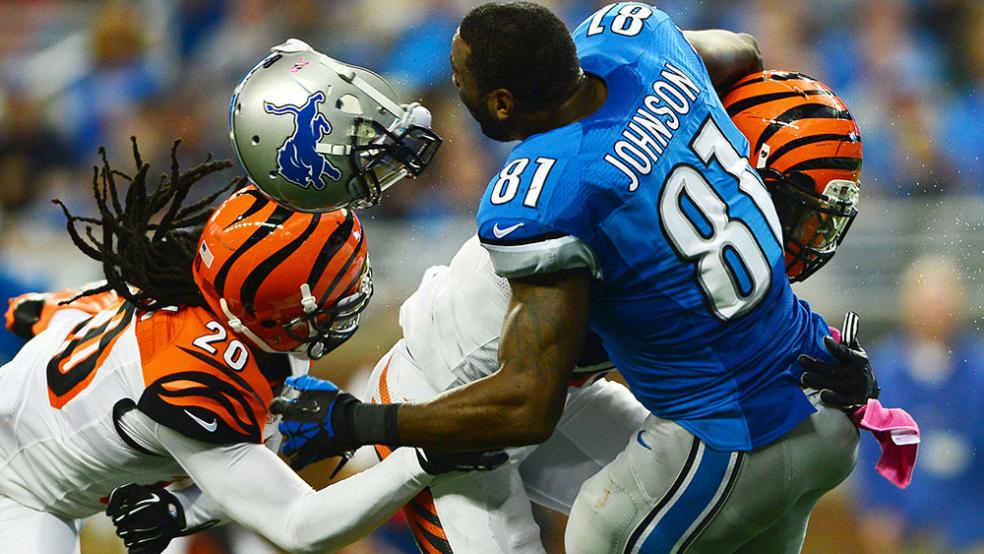America’s national pastime is said to be baseball, but its passion is football--a passion that many are beginning to question every time they see a player hit head on by a 300 pound tackle.
Even though fans seem to love the gladiator-like violence of the game, a new awareness of the disabling impact of brain concussions is making some of them wince when they see a player crunched. That alone might worry the NFL in addition to any further payouts to players on top of the $765 million settlement already awarded last August.
Related: Concussion Research Gets a $14 Million Boost
The real threat to the future of football is not in the lawsuits and payouts—the NFL has plenty of greenbacks. The risk is having an ever weaker bench as parents of high school kids think twice about their sons going out for the team.
Moms Team, a website that boasts it’s “the trusted source for sports parents” says, “High school athletes sustain an estimated 136,000 to 300,000 concussions per year,” with 29 percent of all sports-related concussions concentrated between the ages of 16 to 19. Parents have certainly gotten the message. ESPN reported last November, “The nation's largest youth football program, Pop Warner, saw participation drop 9.5 percent between 2010-12, a sign that the concussion crisis that began in the NFL is having a dramatic impact at the lowest rungs of the sport.”
Those low rungs are pro football’s family farm teams—the Friday night bright lights that keep weeding out the weak players to build the gladiators that you see on any given Sunday. That’s why the NFL is opening the checkbook to help solve the problem….or make people think they have.
Throwing a Hail Mary Pass at a Solution
Football is a BIG sport—big money, big guys, and even bigger risks. Every guy on the field knows he can be crippled in an instant like quarterback Joe Theismann was in 1985 when linebacker Lawrence Taylor turned his leg into splinters; or when Mike Utley was paralyzed from the neck down after a play. But a concussion isn’t considered an injury. Huh?
Related: The Big Business of College Football—Who’s Winning?
An article last January in Esquire by Tom Junod explored injuries from the point of view of the players. In “Theater of Pain” Junod spoke with Willis McGahee who had suffered two excruciating injuries—one when he blew up his knee as a college player; the other when he was a running back with the Baltimore Ravens in a game against the Pittsburgh Steelers.
Junod wanted to know how those two injuries defined McGahee’s career:
"Injury has not been part of my career," he said. "I've only gotten hurt twice. I got hurt once in college and once in the pros."
Right, but that second injury, against the Steelers...
"No. I mean now. The MCL."
"So you don't consider the concussion an injury?"
"That's what they consider it. But getting a concussion and hurting your knee are two different things. You get back up from a concussion."
McGahee may already be suffering from suspension of disbelief over the hits he’s taken. Or he may be motivated by his contract with the Cleveland Browns as a running back who wants to stay in the game.
The NFL wants the game to stay, too. That’s why they’ve launched a $10 million incentive program to find innovative new shock absorbent materials for helmets. There have been dramatic advances in helmet technology over the last few years, including embedded impact sensors that measure the g-forces of a hit to the head and neck. But they’re used primarily in high school and college on an experimental basis.
Now, with the mother of all football teams entering the arena, tech helmets are going to be standard issue.
But do they really work?
Related: 9 Sports Superstars You've Never Heard Of
"That's what we're investigating here, to try to see if there's a better helmet out there, there's a better protection for the head," said NFL Commissioner Roger Goodell at the Head Health Challenge II event, according to USA Today.
"And there are a lot of materials out there that may be created for some other purpose that might work very well here. … You have to study the unintended consequences. If the helmet is sticky, could that cause more neck injuries? So you've got to … do the science. … And that's what this innovation challenge is – to find out if there is some new material, there is some new technology and then test it."
One new possibility comes from Reebok. It’s like do rag with sensors that lights up on impact. (See video below)
Helmet technology may offer a warning sign, but it won’t prevent a concussion. At least not according to Eric Schneiderman, New York’s Attorney General. He said that companies that are marketing “anti-concussive” helmets are misleading the public, including parents and players.
He’s right. The damage comes from within the skull--like shaken baby syndrome--as well as from outside the skull. It’s the g-force of the impact that causes the brain to hit the inside of the skull at a violent rate that can cause untold damage. Until they can find a way to pad the brain itself inside the skull, let’s just call it unnecessary roughness.
Top Reads at The Fiscal Times:





